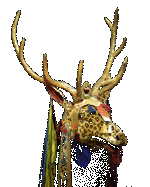|

 |
Deer
(Shava)
Papier- mâché, covered with velvet; late 19th-early
20th century
Chojin Temple Museum, Ulaan Baatar
While most of the Tsam dances were performed at a slow and solemn
pace, two characters, one wearing a deer’s mask and the other
a buffalo’s mask, performed a spirited, wild dance. They are
the henchmen of Yama, the Supreme Judge of Hell. During this
mad dance the protruding tongue of the deer–with its tip weighed
down by millet grains–would sway back and forth. In addition
to its function as an acolyte of Yama, the deer had another
task. At the conclusion of the Tsam ceremony it chopped up the
lingka (doll of dough), which was now filled with all
the evil that had been banished into it by the terrifying deities.
|
The Tsam and Maidari
festivals which are the focus of the exhibition Dancing Demons:
Ceremonial Masks of Mongolia were among the most important of
the Mongolian religious calendar. Although attaining their most
elaborate and spectacular form in Mongolia, they were Tibetan in
origin and were practiced in many of the regions in which Tibetan
Buddhism was influential.
|
